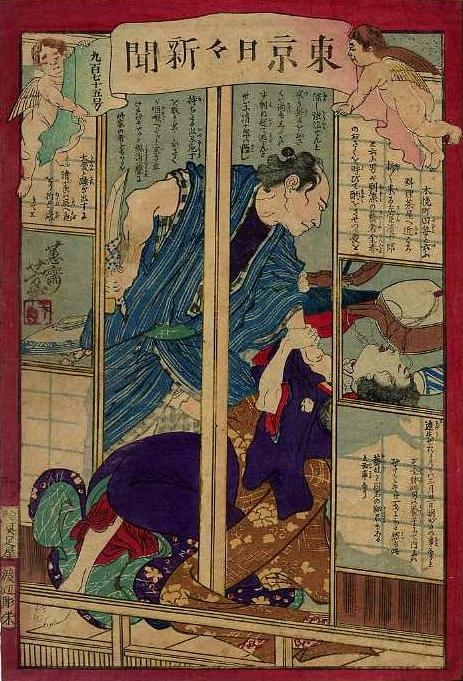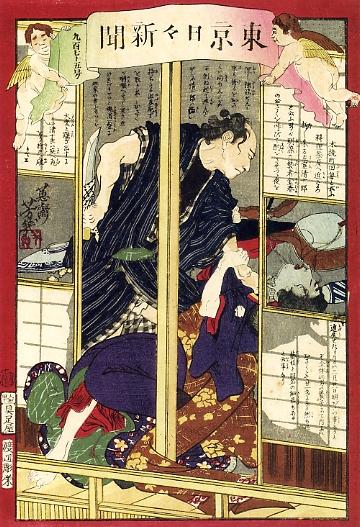Miyuki shoji
The scene is drawn as viewed from the garden of the establishment, looking over the veranda into the room, through partly opened shoji.
Note that the shoji have a pane of glass in the middle between the translucent paper on top and bottom. Such shoji are called "miyuki shōji" (雪見障子), meaning "snow-viewing shoji". Note also that the story has been printed so as not to obstruct the view through the panes of glass.
As seen through the glass, the womans face and neck, the man's hand gripping her neck, and the shamisen and pillow by her head on the right -- and what appears to be the lid of an earthenware pot used for cooking food at a table -- are rendered a pale blue like the unhoned part of the blade of the knife -- rather than left white. Whereas the gray patterns on the transluscent paper below the panes of glass appear to be "silhouettes" (as they are called in CCMA 2008, page 66).
Commentary
From 1878, Honbancho became part of Kyōbashi-ku of Tokyo prefecture (東京府). The neighborhood was in the Tsukiji area of present-day Chōō-ku in Tokyo just to the east of the Ginza area.
geisha reflects 藝者 marked "geisha", while entertainer reflects 藝妓 marked "keigi", apparently an error for "geigi".
the geisha Osaku of Konparu reflects 藝者金春のおさく (geisha Konparu no Osaku). "Konparu" refers to both a style of music associated with nō drama, and to the area around present-day Konpari-dōri (金春通り), a back street in Ginza 8-chome in the Shinbashi area, just off Chūō-dōri, which runs from Shinbashi to Kyōbashi through Ginza. The area, close to Honbancho, was home to the Konparu house of nō musicians, and many geisha who, whether or not they were trained in its style, were employed in local houses of entertainment.
Such geisha were more generally called "Konparu geisha" (金春芸者). Ian McArthur, in his doctoral disseration, Mediating modernity: Henry Black and narrated hybridity in Meiji Japan (University of Sydney, 2002), makes this observation about them (pages 204-205, footnote 109).
|
According to 'Konparu geisha to Shinbashi' in Edo Tôkyô gaku jiten, Sanseidô, Tokyo, p. 926, in the Edo period, the brothel quarters were in Yanagibashi and Fukagawa, but shifted from just before the start of the Meiji period to Shinbashi. Entertainers known as 'konparu geisha' were associated with Shinbashi which became a place of entertainment favored by officials from the new Meiji period governments. Yanagibashi remained as an entertainment quarter associated with those who sympathized with the old bakufu. |
rape reflects 強淫 (gōin), literally "forced wantonness" or the like. Today "rape" is usually 強姦 (gōkan), which appears in some other stories in this series, such as TNS-824 Beautiful robber-rapist. 強姦 was sometimes written 強奸 (gōkan), as in TNS-1009 Impotent necrophiliac), where oddly it is marked to be read as "g!in" as though to mean 強淫.
broad blade butcher knife reflects 出刃庖丁 (deba hōchō), a large knife with a thick, wide, pointed blade suitable for roughly dressing larger fish and fowl before cutting the meat into smaller slices. The knives were heavy and sharp enough to cleave through thicker flesh and bone.
at home reflects 内にハ (uchi ni wa), meaning in one's own family, or at times in another person's family referred to from the other person's point of view.
superior reflects 細君, read "saikun" in Sino-Japanese and meaning something like "little lady" or wife. Here the graphs are marked "kamisan", meaning "above person" or "superior", with the nuance of "little lady" or "old lady" in reference to one's own wife, or at times to sometime else's wife. The expression "uchi no kamisan" is still heard, especially but not only in dubs of Lt. Columbo's references to "my wife" or "Mrs. Columbo", which similarly show a respect that is at once affectionate and humorous.

